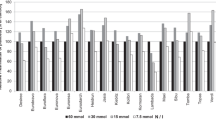Summary
A more thorough understanding of the biochemical basis of superior performance of one alfalfa (Medicago sativa L.) genotype compared to another would expedite improvement in agronomically useful genotypes. Information on thermal dependence of glutathione reductase (GR, E.C. 1.6.4.2) in different ploidy levels of alfalfa is lacking. Our objective was to investigate the thermal dependency of GR in two genetically comparable populations of alfalfa at diploid and tetraploid levels. Thermal stability was similar for the enzyme from both populations, whereas variation was found for: i) the minimum apparent Km (0.53 and 4.14 μM NADPH), ii) the temperature at which the minimum apparent Km was observed (15 and 25° C), and iii) the thermal kinetic windows (TKW) (the temperature range over which the apparent Km is within 200% of the observed minimum Km, 5 and 20° C width) in diploid and tetraploid alfalfa, respectively. The TKW data suggest that the diploid can perform optimally under a narrower (i.e. smaller TKW) and lower range (i.e. the temperature at which the lowest Km was observed) of temperatures, whereas the tetraploid can perform optimally under a wider range (i.e. larger TKW) of temperatures. This finding is in agreement with previously published growth data on near-isogenic populations of diploid and tetraploid alfalfa.
Similar content being viewed by others
Abbreviations
- GR:
-
glutathione reductase
- TKW:
-
thermal kinetic window
- Km:
-
apparent Km
References
Arbi, N., D. Smith & E.T. Bingham, 1979. Dry matter and morphological responses to temperatures of alfalfa strains with differing ploidy levels. Agron. J. 71: 573–577.
Bingham, E.T., 1991. Registration of W2xiso-1 and W4xiso-1 isogenic populations of diploid and tetraploid alfalfa. Crop Sci. 31 (in press).
Bingham, E.T. & T.J. McCoy, 1979. Cultivated alfalfa at the diploid level: Origin, reproductive stability, and yield of seed and forage. Crop Sci. 19: 97–100.
Bradford, M.M., 1976. A rapid and sensitive method for the quantification of microgram quantities of protein utilizing the principle of protein-dye binding. Anal. Biochem. 72: 248–254.
Burke, J.J., J.R. Mahan & J.L. Hatfield, 1988. Crop specific thermal kinetic windows in relation to wheat and cotton biomass production. Agron. J. 80: 553–556.
Cornish-Bowden, A., 1979. Fundamentals of enzyme kinetics. Butterworths, London.
Garrett, M.K., 1978. Control of photorespiration at RuBP carboxylase/oxygenase level in ryegrass cultivars. Nature 274: 913–915.
Habben, J.E. & J.J. Volenec, 1989. Amylolytic activity in taproots of diploid and tetraploid alfalfa during foliar regrowth. p. 112. In Agronomy abstracts. ASA, Madison, WI.
Halliwell, B. & C.H. Foyer, 1978. Properties and physiological function of a glutathione reductase purified from spinach leaves by affinity chromatography. Planta 139: 9–17.
Joseph, M.C., D.D. Randall & C.J. Nelson, 1981. Photosynthesis in polyploid tall fescue. II. Photosynthesis and ribulose-1,5-bisphosphate carboxylase of polyploid tall fescue. Plant Physiol. 68: 894–898.
Kalt-Torres, W., J.J. Burke & J.M. Anderson, 1984. Chloroplast glutathione reductase: Purification and properties. Physiol. Plant. 61: 271–278.
Kidambi, S.P., J.R. Mahan & A.G. Matches, 1990a. Purification and thermal dependence of glutathione reductase from two forage legume species. Plant Physiol. 92: 363–367.
Kidambi, S.P., J.R. Mahan & A.G. Matches, 1990b. Interspecific variation for thermal dependence of glutathione reductase in sainfoin. Theor. Appl. Genet. 79: 600–604.
Leps, W.T., W.J. Brill & E.T. Bingham, 1980. Effect of alfalfa ploidy on nitrogen fixation. Crop Sci. 20: 427–430.
Mahan, J.R., J.J. Burke & K.A. Orzech, 1990. The thermal kinetic window as an indicator of optimum plant temperature. Plant Physiol. 93: 822–824.
Meyers, S.P., S.L. Nichols, G.R. Baer, W.T. Molin & L.E. Schrader, 1982. Ploidy effects in isogenic populations of alfalfa. I. Ribulose-1,5-bisphosphate carboxylase, soluble protein, chlorophyll, and DNA in leaves. Plant Physiol. 70: 1704–1709.
Patterson, B.D. & D. Graham, 1987. Temperature and Metabolism. In: P.K.Stumpf & E.E.Conn (Eds), The Biochemistry of Plants: A comprehensive treatise. pp. 153–199. Academic Press, New York.
Pfahler, P.L., R.D. Barnett & H.H. Luke, 1984. Diploid-tetraploid comparisons in rye. I. Forage production. Crop Sci. 24: 671–674.
Somero, G.N., 1975. Temperature as a selective factor in protein evolution: The adaptational strategy of “compromise”. J. Zool. 194: 175–188.
Volenec, J.J., 1988. Herbage growth and carbohydrate metabolism of diploid and tetraploid alfalfa. Crop Sci. 28: 128–132.
Author information
Authors and Affiliations
Additional information
This work was supported by USDA Specific Cooperative Agreement No. 58-7MN1-8-143 from the Plant Stress and Water Conservation Unit, USDA-ARS, Lubbock, Texas. Joint contribution of the Texas Tech University, USDA-ARS, Lubbock, TX and University of Wisconsin, Madison, WI. TTU Journal No. T-4-306.
Rights and permissions
About this article
Cite this article
Kidambi, S.P., Mahan, J.R., Matches, A.G. et al. Thermal dependence of glutathione reductase in one tetraploid and its near-isogenic diploid alfalfa. Euphytica 52, 165–170 (1991). https://doi.org/10.1007/BF00029392
Received:
Accepted:
Issue Date:
DOI: https://doi.org/10.1007/BF00029392




